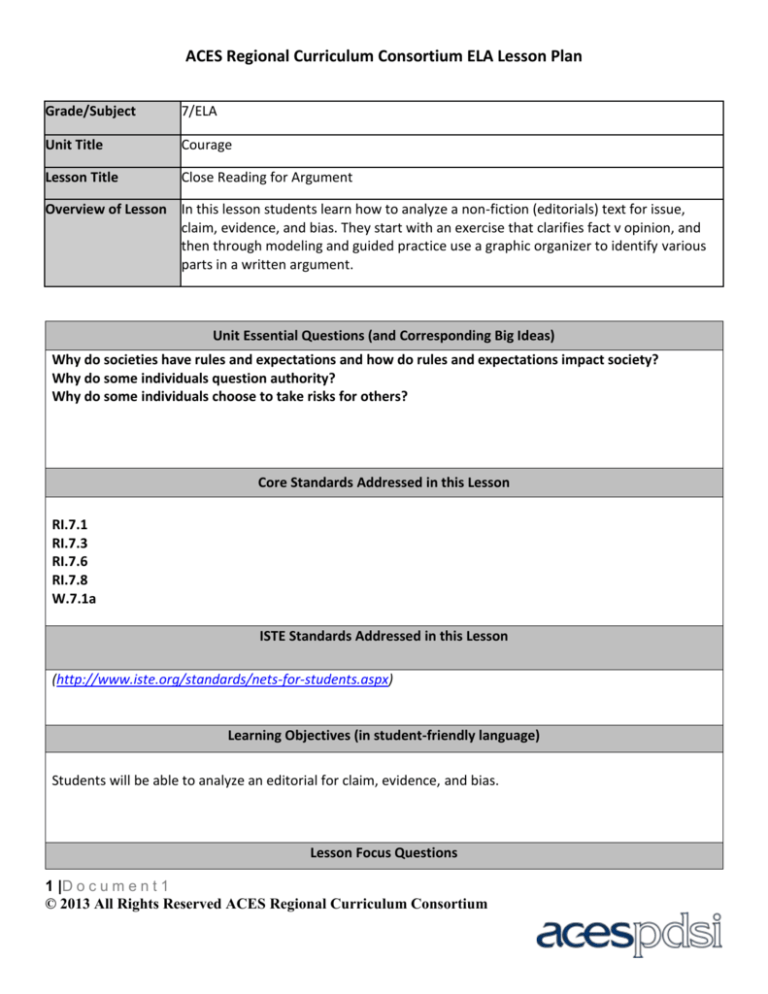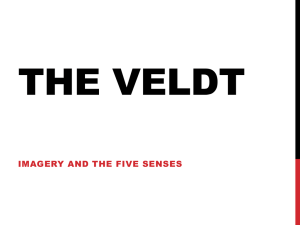
ACES Regional Curriculum Consortium ELA Lesson Plan
Grade/Subject
7/ELA
Unit Title
Courage
Lesson Title
Close Reading for Argument
Overview of Lesson In this lesson students learn how to analyze a non-fiction (editorials) text for issue,
claim, evidence, and bias. They start with an exercise that clarifies fact v opinion, and
then through modeling and guided practice use a graphic organizer to identify various
parts in a written argument.
Unit Essential Questions (and Corresponding Big Ideas)
Why do societies have rules and expectations and how do rules and expectations impact society?
Why do some individuals question authority?
Why do some individuals choose to take risks for others?
Core Standards Addressed in this Lesson
RI.7.1
RI.7.3
RI.7.6
RI.7.8
W.7.1a
ISTE Standards Addressed in this Lesson
(http://www.iste.org/standards/nets-for-students.aspx)
Learning Objectives (in student-friendly language)
Students will be able to analyze an editorial for claim, evidence, and bias.
Lesson Focus Questions
1 |D o c u m e n t 1
© 2013 All Rights Reserved ACES Regional Curriculum Consortium
ACES Regional Curriculum Consortium ELA Lesson Plan
How do readers determine bias and point of view in an argument?
How do writers use evidence to effectively support an argument?
Suggested Texts
Title
Author
BRIEF Synopsis
Genre
Non-fiction
editorial
Non-fiction
editorial
Non-fiction
editorial
Supplemental Materials and Resources
www.procon.org
www.iconn.org
http://learning.blogs.nytimes.com/?s=vietnam+war
Preparation Required (and suggested)
Make copies of all Op-Eds and graphic organizer
2 |D o c u m e n t 1
© 2013 All Rights Reserved ACES Regional Curriculum Consortium
Lexile/
F&P
ACES Regional Curriculum Consortium ELA Lesson Plan
Anticipated Misconceptions for This Lesson
We can believe everything read as truth. Students don’t always understand that just because
someone makes an argument and uses evidence, that doesn’t mean it’s the “truth” or fact.
Fact and opinion are the same. Students often think fact and opinion are synonyms.
The news doesn’t have bias. They may not understand that certain sections of the newspaper, like an
Op-Ed, are designed to convey bias.
Lesson Development
Annotation
Introduction:
Entrance Slip: When students arrive they will complete the “Fact v
Opinion” worksheet and share results with a neighbor.
Class will create a brief list of what makes something a fact v what
makes something an opinion. Teacher will record answers.
Students will re-evaluate their answers on the worksheet to see if
they’ve changed their mind. They adjust their answers as needed.
Teacher shares the answers and clarifies as needed.
Students think critically and adjust their
own answers based on the new learning.
Teacher will tell students not to worry about
the column evidence type since that’s a lesson
for later.
During:
Teacher will model analyzing an Op-Ed “enter title here” for issue,
claim, evidence, and bias. Teacher will think aloud as teacher fills in
the graphic organizer.
Teacher will jigsaw guided practice by dividing students into groups of
4-5. Each group will receive a different Op-Ed on the same subject.
Students will read, analyze, and complete the graphic organizer to
determine the issue, the claim, the evidence, and the bias.
Before groups share, students will take a few minutes to write in their
journals: Summarize what was discussed in your group? How’d it go?
Did people seem to have a lot to talk about? Were you all reaching for
something to say?
Groups will share their findings.
Closure:
Teacher will facilitate a discussion that synthesizes the learning about
writing arguments:
3 |D o c u m e n t 1
© 2013 All Rights Reserved ACES Regional Curriculum Consortium
Texts will be differentiated by complexity.
Teacher will go around to each group and
check for understanding.
Teacher will use the metacognition of students
as a formative assessment.
Teacher will continue to push groups to return
to their texts and quote from them to explain
their thinking.
Save enough time to have a meaningful
ACES Regional Curriculum Consortium ELA Lesson Plan
o
o
What did we learn about how people think about this topic?
How did they support their claim? What kind of evidence did
writers use? (facts, anecdotes, stats, real-life examples, expert
testimony)
o How did the writers show their bias? (diction, types of details
for evidence, tone)
Students will independently analyze an op-ed for homework and
complete the graphic organizer.
Formative Assessment Processes/Practices
Entrance slip will tell us what they know about fact and opinion.
Rounds during guided practice – their discussion as well as what they
fill out on the graphic organizer.
The final discussion will expose understanding or not.
The independent practice for homework.
4 |D o c u m e n t 1
© 2013 All Rights Reserved ACES Regional Curriculum Consortium
discussion about this. The goal of this
discussion is for students to have an
understanding about how we use evidence to
support our claims and that the evidence we
choose exposes bias.
This will be a formative assessment.
Annotation






